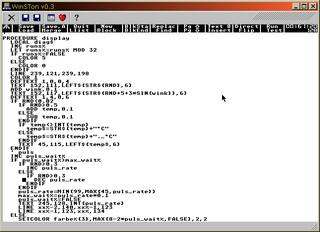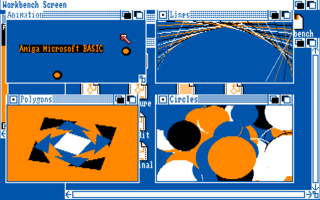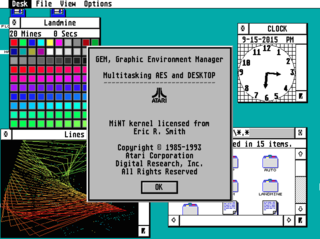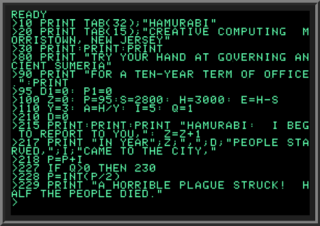
Atari ST is a line of personal computers from Atari Corporation and the successor to the company's 8-bit home computers. The initial model, the Atari 520ST, had limited release in April–June 1985, and was widely available in July. It was the first personal computer with a bitmapped color graphical user interface, using a version of Digital Research's GEM interface / operating system from February 1985. The Atari 1040ST, released in 1986 with 1 MB of memory, was the first home computer with a cost per kilobyte of RAM under US$1/KB.

AMOS BASIC is a dialect of the BASIC programming language for the Amiga computer. Following on from the successful STOS BASIC for the Atari ST, AMOS BASIC was written for the Amiga by François Lionet with Constantin Sotiropoulos and published by Europress Software in 1990.

BASIC is a family of general-purpose, high-level programming languages designed for ease of use. The original version was created by John G. Kemeny and Thomas E. Kurtz at Dartmouth College in 1963. They wanted to enable students in non-scientific fields to use computers. At the time, nearly all computers required writing custom software, which only scientists and mathematicians tended to learn.

Atari BASIC is an interpreter for the BASIC programming language that shipped with Atari 8-bit computers. Unlike most American BASICs of the home computer era, Atari BASIC is not a derivative of Microsoft BASIC and differs in significant ways. It includes keywords for Atari-specific features and lacks support for string arrays.

In computing, PEEK and POKE are commands used in some high-level programming languages for accessing the contents of a specific memory cell referenced by its memory address. PEEK gets the byte located at the specified memory address. POKE sets the memory byte at the specified address. These commands originated with machine code monitors such as the DECsystem-10 monitor; these commands are particularly associated with the BASIC programming language, though some other languages such as Pascal and COMAL also have these commands. These commands are comparable in their roles to pointers in the C language and some other programming languages.

Deluxe Paint, often referred to as DPaint, is a bitmap graphics editor created by Dan Silva for Electronic Arts and published for the then-new Amiga 1000 in November 1985. A series of updated versions followed, some of which were ported to other platforms. An MS-DOS release with support for the 256 color VGA standard became popular for creating pixel graphics in video games in the 1990s.

GFA BASIC is a dialect of the BASIC programming language, by Frank Ostrowski. The name is derived from the company, which distributed the software. In the mid-1980s to the 1990s it enjoyed popularity as an advanced BASIC dialect, but has been mostly superseded by several other programming languages. Official support ended in the early 2000s.

A type-in program or type-in listing was computer source code printed in a home computer magazine or book. It was meant to be entered via the keyboard by the reader and then saved to cassette tape or floppy disk. The result was a usable game, utility, or application program.

Turbo-BASIC XL is an enhanced version of the BASIC programming language for Atari 8-bit computers. It is a compatible superset of the Atari BASIC that shipped with the Atari 8-bit systems. Turbo-Basic XL was developed by Frank Ostrowski and published in the December 1985 issue of German computer magazine Happy Computer. A version for the 400/800 models was released shortly after as Frost Basic 1.4. Several modified versions working with different DOS systems have been released by other authors.

STOS BASIC is a dialect of the BASIC programming language for the Atari ST personal computer. It was designed for creating games, but the set of high-level graphics and sound commands it offers is suitable for developing multimedia software without knowledge of the internals of the Atari ST.

Amiga Basic is an interpreted implementation of the BASIC programming language for the Amiga. It was designed and written by Microsoft. Amiga Basic shipped with AmigaOS versions 1.1 to 1.3. It succeeded MetaComCo's ABasiC included in AmigaOS 1.0 and 1.1 and was superseded by ARexx, a REXX-style scripting language, from AmigaOS version 2.0 onwards.
HP Time-Shared BASIC is a BASIC programming language interpreter for Hewlett-Packard's HP 2000 line of minicomputer-based time-sharing computer systems. TSB is historically notable as the platform that released the first public versions of the game Star Trek.
Optimized Systems Software (OSS) was a company that produced disk operating systems, programming languages with integrated development environments, and applications primarily for Atari 8-bit computers. The founders of OSS previously developed Atari DOS, Atari BASIC, and the Atari Assembler Editor for Atari, Inc., and many OSS products are substantially improved versions. OS A+ and DOS XL are based on Atari DOS. BASIC A+, BASIC XL, and BASIC XE are based on Atari BASIC. EASMD and MAC/65 are modeled on the Atari Assembler Editor. Action! is an ALGOL-inspired compiled programming language with an integrated full-screen editor. OSS also sold some software for the Apple II.

Antic was a print magazine devoted to Atari 8-bit computers and later the Atari ST. It was named after the ANTIC chip in the 8-bit line which, in concert with CTIA or GTIA, generates the display. The magazine was published by Antic Publishing from April 1982 until June/July 1990.Antic printed type-in programs, reviews, and tutorials, among other articles. Each issue contained one type-in game as "Game of the Month." In 1986, STart magazine was spun off to exclusively cover the Atari ST line.

TOS is the operating system of the Atari ST range of computers. This range includes the 520ST and 1040ST, their STF/M/FM and STE variants and the Mega ST/STE. Later, 32-bit machines were developed using a new version of TOS, called MultiTOS, which allowed multitasking. More recently, users have further developed TOS into FreeMiNT.

The first version of Microsoft Word was developed by Charles Simonyi and Richard Brodie, former Xerox programmers hired by Bill Gates and Paul Allen in 1981. Both programmers worked on Xerox Bravo, the first WYSIWYG word processor. The first Word version, Word 1.0, was released in October 1983 for Xenix, MS-DOS, and IBM; it was followed by four very similar versions that were not very successful. The first Windows version was released in 1989, with a slightly improved interface. When Windows 3.0 was released in 1990, Word became a huge commercial success. Word for Windows 1.0 was followed by Word 2.0 in 1991 and Word 6.0 in 1993. Then it was renamed to Word 95 and Word 97, Word 2000 and Word for Office XP. With the release of Word 2003, the numbering was again year-based. Since then, Windows versions include Word 2007, Word 2010, Word 2013, Word 2016, and most recently, Word for Office 365.
This article deals with programming languages used in the Amiga line of computers, running the AmigaOS operating system and its derivatives AROS and MorphOS. It is a split of the main article Amiga software. See also related articles Amiga productivity software, Amiga music software, Amiga Internet and communications software and Amiga support and maintenance software for other information regarding software that runs on Amiga.

A BASIC interpreter is an interpreter that enables users to enter and run programs in the BASIC language and was, for the first part of the microcomputer era, the default application that computers would launch. Users were expected to use the BASIC interpreter to type in programs or to load programs from storage.
BASIC-8, is a BASIC programming language for the Digital Equipment (DEC) PDP-8 series minicomputers. It was the first BASIC dialect released by the company, and its success led DEC to produce new BASICs for its future machines, notably BASIC-PLUS for the PDP-11 series. DEC's adoption of BASIC cemented the use of the language as the standard educational and utility programming language of its era, which combined with its small system requirements, made BASIC the major language during the launch of microcomputers in the mid-1970s.















